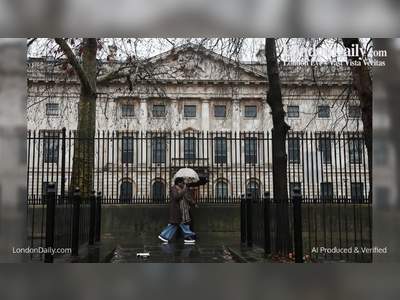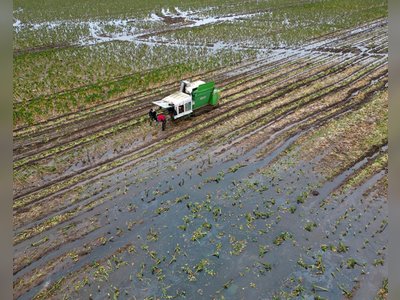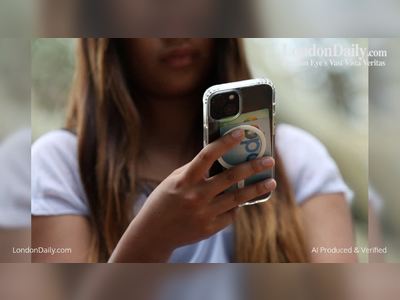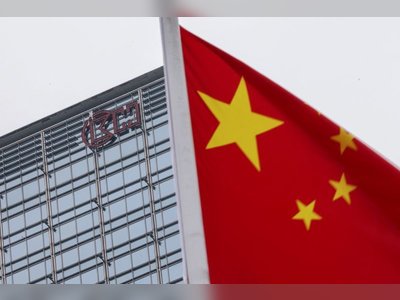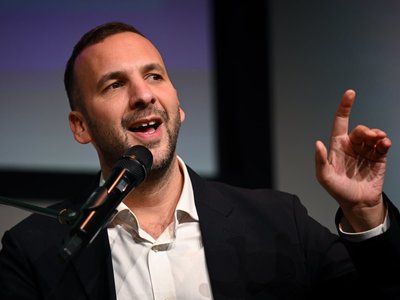
The World Should Prepare for a Double Pandemic
COVID-19 has steamrolled the world. What happens if another pandemic starts before this one is over?
Seven years ago, the White House was bracing itself for not one pandemic, but two. In the spring of 2013, several people in China fell sick with a new and lethal strain of H7N9 bird flu, while an outbreak of MERS—a disease caused by a coronavirus—had spread from Saudi Arabia to several other countries. “We were dealing with the potential for both of those things to become a pandemic,” says Beth Cameron, who was on the National Security Council at the time.
Neither did, thankfully, but we shouldn’t mistake historical luck for future security. Viruses aren’t sporting. They will not refrain from kicking you just because another virus has already knocked you to the floor. And pandemics are capricious. Despite a lot of research, “we haven’t found a way to predict when a new one will arrive,” says Nídia Trovão, a virologist at the National Institutes of Health. As new diseases emerge at a quickening pace, the only certainty is that pandemics are inevitable. So it is only a matter of time before two emerge at once.
“We have to prepare for a pandemic to happen at any time, and ‘any time’ can be when we’re already dealing with one pandemic,” Cameron told me.
I first worried about the possibility of a double pandemic in March. Four months ago, it felt needlessly alarmist to fret about two rare events happening simultaneously. But since then, federal fecklessness and rushed reopenings have wasted the benefits of months of social distancing. About 60,000 new cases of COVID-19 are being confirmed every day, and death rates are rising. My worry from March feels less far-fetched. If America could underperform so badly against one rapidly spreading virus, how would it fare against two?
COVID-19 has made clear what happens when even powerful, wealthy countries are inadequately prepared for rare but ruinous events. Months into the pandemic, international alliances are strained, resources are diminished, and experts are demoralized. The longer this fiasco drags on, the more vulnerable America becomes to further disasters: inbound hurricanes, wildfires, and many other viruses that lie in wait.
Sars-cov-2, the coronavirus that causes COVID-19, is just one of many coronaviruses that exist in bats and other wild animals. Several strains of influenza with pandemic potential are lurking in pigs and poultry, and some have repeatedly infected farmers over the past decade. Wild mammals harbor an estimated 40,000 unknown viruses, a quarter of which could conceivably jump into humans. Changing climate and shrinking habitats have brought those viruses into closer contact with people and livestock, while crowded cities and air travel hasten their spread. “If another pandemic happens, it will follow the same path the first one took, carved out by the world we created,” says Jessica Metcalf, an infectious-disease ecologist at Princeton.
Certain traits increase a pathogen’s pandemic potential. Those that spread via bodily fluids (Ebola), contaminated food and water (norovirus), or insect bites (Zika) are slower to spread around the world. By contrast, respiratory viruses like flu, which spread through coughs, sneezes, and exhalations, could conceivably travel fast enough to overlap with COVID-19.
Many countries are on high alert for such viruses, primed by their COVID-19 ordeal in the same way that East Asian countries were primed at the start of this pandemic by their previous run-ins with SARS and MERS. But waning global solidarity is a problem. “Our international laws are based on a bargain that countries will rapidly notify each other [about emerging diseases] and, in exchange, they’ll have protection against the economic impacts of sharing that info,” says Alexandra Phelan of Georgetown University, who works on legal and policy issues related to infectious diseases. That compact was violated during COVID-19, after China suppressed information about the outbreak and other countries quickly implemented travel bans. The U.S. is now on the receiving end of many such bans.
Having failed to lead the best-prepared nation in the world against one pandemic, Donald Trump has made it more vulnerable to another. He has, for example, frayed international bonds further by trying to pull the U.S. out of the World Health Organization. Whether he has the legal authority to do so is still unclear, but even if the threat is empty, “some of the effects will be immediate,” says Loyce Pace, the president of the Global Health Council. U.S. officials and experts will start disengaging from international institutions, and that might encourage other nations to follow suit.
This won’t just harm the WHO at the time when it is most needed, but will also further diminish America’s already damaged international standing. A country that has badly mishandled its own outbreak, that has bought up the world’s stock of important drugs, and that has petulantly withdrawn from global alliances is less likely to receive warnings or support if a new crisis emerges.
There is an optimistic scenario if a second virus begins to spread: The new pathogen finds it harder to move around an alert world, is rapidly detected wherever it arrives, and fizzles out because cautious citizens have their guard up.
As long as people stay vigilant against the current pandemic—keeping their distance, wearing masks, avoiding indoor crowds—they should theoretically be guarded against a second respiratory virus. It used to be common for measles and pertussis to interfere with each other, so that if one spiked, the other would subside. That might be because kids who got one disease would stay home, reducing their risk of the other. “It’s nothing to do with a vaccine or the immune system,” says Sarah Cobey, an immunologist at the University of Chicago. “It’s just people being careful.”
The same tests that are being used to diagnose COVID-19 could also be tweaked to cover the new pathogen. One company is already developing a fast “multiplex” test that could look for four respiratory viruses—the new coronavirus, two types of flu, and respiratory syncytial virus (RSV)—in a single nasal swab. And if the new pathogen is a flu strain, existing vaccines could be tweaked to protect against it. That would still take several months, but the existence of a seasonal flu vaccine offers an invaluable head start.
This future is easier to imagine in countries like South Korea, New Zealand, and Germany, which have successfully controlled COVID-19. It seems less likely in nations like the U.S., Brazil, Russia, and India, which are stretched and struggling.
In such places, COVID-19 would effectively cloak the spread of any new respiratory virus with similar symptoms, which “could have a chance to take off before we realized it had,” Cameron said. A new virus would also be harder to spot because “all the resources we would normally use to detect potential viruses of concern have been redirected for COVID-19,” says Lauren Sauer, who works on disaster preparedness at Johns Hopkins Medicine. She means everything from physical equipment like swabs and storage tubes, to health-care workers who administer and process tests, to public-health experts who analyze the data or conduct contact tracing. These are either running out or burning out. A second respiratory virus would further tax the same resources that the U.S. has already failed to adequately marshal for COVID-19.
Hospitals would also struggle. In many states, emergency rooms and intensive-care units are filling up. A second virus wouldn’t need to be that severe to push them beyond their capacity, deplete the shrinking supply of protective equipment, or create a logistical nightmare. “Say we had pandemic flu and COVID at the same time,” Sauer told me. “You have two groups of people who need to be sorted and separated,” lest those with only one virus infect those who have only the other. Doctors and nurses would face complicated protocols about whom they could treat, having already run on fumes for months. “People are spent,” Pace, the Global Health Council president, told me. “We are very resilient, but we have our limits.”
A second virus would be especially devastating if it targeted a different slice of the populace than COVID-19. Unlike SARS-CoV-2, many respiratory viruses disproportionately affect children, and the 1918 flu pandemic was especially deadly for adults ages 20 to 40. “Something that decimates children or young people is a different ballgame,” says Zeynep Tufekci, a sociologist at the University of North Carolina and an Atlantic contributor. “It’d be economically devastating, and you’d no longer have an age group that’s protected.” The current debate about opening schools would be completely off the table. “In such a case, 1 plus 1 isn’t 2, but 10,” she adds.
It’s certainly possible for people to contract multiple respiratory viruses at once, and in early spring, some adults were indeed infected with both flu and SARS-CoV-2. But it’s hard to predict what happens when two severe pathogens hit the same person. Viruses reproduce by co-opting their host’s cells, and two of them might obstruct each other by competing for the same cellular machinery. It’s also possible that one would trigger a generic immune response, like inflammation, that would make it harder for the second to take hold. Then again, it’s also possible that two severe diseases would compound each other. “The knotty heart of all these problems is the immune system,” Metcalf told me, which is so complicated that trying to understand it, much less predict it, “is just miserable.”
Untangling those knots is especially hard in the midst of a pandemic. Currently, the scientific community is hell-bent on studying COVID-19, but basic questions remain unanswered. Why do some people get sick and others do not? What’s the full range of symptoms? Why do some people infect many while many infect no one? “Look at the energy it’s taking,” says Nahid Bhadelia, an infectious-disease physician at Boston University, “and the level of uncertainty” that just one new virus creates. Scientists, much like the health-care and public-health communities, are neither infinite nor indefatigable. A second virus would more than double their burden because they would have to analyze the diseases individually, as well as any interactions between them.
Mysteries would linger. Uncertainty would deepen. The vortex of confusion in which we have swirled for months would spin faster. Already, a single pandemic has pushed people toward baseless theories about deliberately engineered viruses. Such conspiracies will burn even brighter if a second improbable event occurs.
On july 6, several reports noted that a case of bubonic plague had been detected in Inner Mongolia, a region of northern China. That should have been considered neither odd nor alarming. Plague is endemic among the region’s rodents, as it is among those of the southwestern United States. A handful of Americans come down with plague every year. The disease is treatable with antibiotics. And yet, the plague story was widely read. “Really, 2020?” wrote many a Twitter user. (Yesterday, a squirrel tested positive for plague in Colorado, prompting another wave of headlines.)
The threats that draw the most attention are not necessarily the most dangerous ones. While Americans freaked out in May about so-called murder hornets, the worst locust outbreak in 70 years devastated croplands in East Africa and South Asia. While a single case of plague in China made headlines, the Democratic Republic of the Congo was being dog-piled by dangerous viruses: The nation just beat a two-year Ebola outbreak in its war-ravaged east, only to face another Ebola assault on its western flank, along with COVID-19 and the world’s largest measles outbreak.
The DRC and many other countries are already living through what is functionally identical to a double pandemic—several infectious disasters, overlaying one another. The U.S. is barrelling toward the same situation. Even without a second pandemic, regular seasonal flu strains are inbound. “I’m pretty worried,” Sauer told me. The same demographic of younger adults that accounts for many of America’s surging COVID-19 cases would also drive a bad flu season. And the people who would normally prepare hospitals for such an eventuality have no time to do so. “The idea that someone could conduct a drill in the midst of all of this is not realistic,” Sauer said. “All the people with preparedness jobs have turned into COVID responders. Things are getting dropped.”
As a result, the flu vaccine could be less effective. Flu viruses change constantly, and must be carefully monitored to make sure that this season’s vaccine is a decent match for currently circulating strains. It’s hard to do that with COVID-19 sapping time and energy, which “will hamper our ability to gauge and respond to what’s happening in the middle of this flu season,” says Emily Martin, who studies respiratory viruses at the University of Michigan. “It’ll also affect the vaccine of 2021.”
Other known and preventable diseases will also run amok if the current pandemic continues unabated. The Centers for Disease Control and Prevention reported that in Michigan, the proportion of five-month-olds who are up-to-date on their vaccines fell from 68 percent in May 2019 to 50 percent in May 2020. Childhood vaccinations have also declined in many other states as doctor offices closed or parents canceled appointments.
Global programs that fight HIV, malaria, and tuberculosis are being disrupted as workers are reassigned to fighting COVID-19, supplies run out, and labs are inundated. Vaccination programs were suspended in many countries, leading to rises in measles, cholera, and diphtheria. If such initiatives are paused too long, the world could lose decades of ground against polio—a disease that was almost eradicated. “We’ve been very close to the end of polio for a very long time, and we’re not far away from the scenario where it comes roaring back,” Pace said.
“When two or more diseases cluster, interact, and are driven by some bigger phenomenon,” they are known as “syndemics,” says Emily Mendenhall, a medical anthropologist at Georgetown University. COVID-19, for example, disproportionately affects people with heart disease and diabetes, but all of these illnesses are affected by inequity. America’s legacy of systemic racism means that Black people are more likely to live in poor neighborhoods, to have less access to nutritious food and good health-care, and to work in low-wage “essential” jobs that must continue even in a pandemic. These factors make Black people more prone to both chronic illness and COVID-19, which then exacerbate each other.
The syndemic concept is important because it reminds us that diseases are not just the work of viruses and other pathogens. They are also influenced by every aspect of a society, from cultural values that affect whom it cares for and ignores, to political choices that determine how it responds when challenged. To truly prepare for pandemics, whether one or two or five, the U.S. needs more than biomedical advances like vaccines and drugs. “We need to plug all the holes,” Tufekci told me. That would mean investing in long-neglected public-health systems to ensure universal access to health care, and to dismantle racist policies that have foisted the burden of disease onto marginalized communities.
“Apparently the world needed to hear this, but humanity can’t leave infectious diseases behind,” Tufekci added. “We’re going to have to live with them. We’re more pandemic-friendly as a planet.”
Neither did, thankfully, but we shouldn’t mistake historical luck for future security. Viruses aren’t sporting. They will not refrain from kicking you just because another virus has already knocked you to the floor. And pandemics are capricious. Despite a lot of research, “we haven’t found a way to predict when a new one will arrive,” says Nídia Trovão, a virologist at the National Institutes of Health. As new diseases emerge at a quickening pace, the only certainty is that pandemics are inevitable. So it is only a matter of time before two emerge at once.
“We have to prepare for a pandemic to happen at any time, and ‘any time’ can be when we’re already dealing with one pandemic,” Cameron told me.
I first worried about the possibility of a double pandemic in March. Four months ago, it felt needlessly alarmist to fret about two rare events happening simultaneously. But since then, federal fecklessness and rushed reopenings have wasted the benefits of months of social distancing. About 60,000 new cases of COVID-19 are being confirmed every day, and death rates are rising. My worry from March feels less far-fetched. If America could underperform so badly against one rapidly spreading virus, how would it fare against two?
COVID-19 has made clear what happens when even powerful, wealthy countries are inadequately prepared for rare but ruinous events. Months into the pandemic, international alliances are strained, resources are diminished, and experts are demoralized. The longer this fiasco drags on, the more vulnerable America becomes to further disasters: inbound hurricanes, wildfires, and many other viruses that lie in wait.
Sars-cov-2, the coronavirus that causes COVID-19, is just one of many coronaviruses that exist in bats and other wild animals. Several strains of influenza with pandemic potential are lurking in pigs and poultry, and some have repeatedly infected farmers over the past decade. Wild mammals harbor an estimated 40,000 unknown viruses, a quarter of which could conceivably jump into humans. Changing climate and shrinking habitats have brought those viruses into closer contact with people and livestock, while crowded cities and air travel hasten their spread. “If another pandemic happens, it will follow the same path the first one took, carved out by the world we created,” says Jessica Metcalf, an infectious-disease ecologist at Princeton.
Certain traits increase a pathogen’s pandemic potential. Those that spread via bodily fluids (Ebola), contaminated food and water (norovirus), or insect bites (Zika) are slower to spread around the world. By contrast, respiratory viruses like flu, which spread through coughs, sneezes, and exhalations, could conceivably travel fast enough to overlap with COVID-19.
Many countries are on high alert for such viruses, primed by their COVID-19 ordeal in the same way that East Asian countries were primed at the start of this pandemic by their previous run-ins with SARS and MERS. But waning global solidarity is a problem. “Our international laws are based on a bargain that countries will rapidly notify each other [about emerging diseases] and, in exchange, they’ll have protection against the economic impacts of sharing that info,” says Alexandra Phelan of Georgetown University, who works on legal and policy issues related to infectious diseases. That compact was violated during COVID-19, after China suppressed information about the outbreak and other countries quickly implemented travel bans. The U.S. is now on the receiving end of many such bans.
Having failed to lead the best-prepared nation in the world against one pandemic, Donald Trump has made it more vulnerable to another. He has, for example, frayed international bonds further by trying to pull the U.S. out of the World Health Organization. Whether he has the legal authority to do so is still unclear, but even if the threat is empty, “some of the effects will be immediate,” says Loyce Pace, the president of the Global Health Council. U.S. officials and experts will start disengaging from international institutions, and that might encourage other nations to follow suit.
This won’t just harm the WHO at the time when it is most needed, but will also further diminish America’s already damaged international standing. A country that has badly mishandled its own outbreak, that has bought up the world’s stock of important drugs, and that has petulantly withdrawn from global alliances is less likely to receive warnings or support if a new crisis emerges.
There is an optimistic scenario if a second virus begins to spread: The new pathogen finds it harder to move around an alert world, is rapidly detected wherever it arrives, and fizzles out because cautious citizens have their guard up.
As long as people stay vigilant against the current pandemic—keeping their distance, wearing masks, avoiding indoor crowds—they should theoretically be guarded against a second respiratory virus. It used to be common for measles and pertussis to interfere with each other, so that if one spiked, the other would subside. That might be because kids who got one disease would stay home, reducing their risk of the other. “It’s nothing to do with a vaccine or the immune system,” says Sarah Cobey, an immunologist at the University of Chicago. “It’s just people being careful.”
The same tests that are being used to diagnose COVID-19 could also be tweaked to cover the new pathogen. One company is already developing a fast “multiplex” test that could look for four respiratory viruses—the new coronavirus, two types of flu, and respiratory syncytial virus (RSV)—in a single nasal swab. And if the new pathogen is a flu strain, existing vaccines could be tweaked to protect against it. That would still take several months, but the existence of a seasonal flu vaccine offers an invaluable head start.
This future is easier to imagine in countries like South Korea, New Zealand, and Germany, which have successfully controlled COVID-19. It seems less likely in nations like the U.S., Brazil, Russia, and India, which are stretched and struggling.
In such places, COVID-19 would effectively cloak the spread of any new respiratory virus with similar symptoms, which “could have a chance to take off before we realized it had,” Cameron said. A new virus would also be harder to spot because “all the resources we would normally use to detect potential viruses of concern have been redirected for COVID-19,” says Lauren Sauer, who works on disaster preparedness at Johns Hopkins Medicine. She means everything from physical equipment like swabs and storage tubes, to health-care workers who administer and process tests, to public-health experts who analyze the data or conduct contact tracing. These are either running out or burning out. A second respiratory virus would further tax the same resources that the U.S. has already failed to adequately marshal for COVID-19.
Hospitals would also struggle. In many states, emergency rooms and intensive-care units are filling up. A second virus wouldn’t need to be that severe to push them beyond their capacity, deplete the shrinking supply of protective equipment, or create a logistical nightmare. “Say we had pandemic flu and COVID at the same time,” Sauer told me. “You have two groups of people who need to be sorted and separated,” lest those with only one virus infect those who have only the other. Doctors and nurses would face complicated protocols about whom they could treat, having already run on fumes for months. “People are spent,” Pace, the Global Health Council president, told me. “We are very resilient, but we have our limits.”
A second virus would be especially devastating if it targeted a different slice of the populace than COVID-19. Unlike SARS-CoV-2, many respiratory viruses disproportionately affect children, and the 1918 flu pandemic was especially deadly for adults ages 20 to 40. “Something that decimates children or young people is a different ballgame,” says Zeynep Tufekci, a sociologist at the University of North Carolina and an Atlantic contributor. “It’d be economically devastating, and you’d no longer have an age group that’s protected.” The current debate about opening schools would be completely off the table. “In such a case, 1 plus 1 isn’t 2, but 10,” she adds.
It’s certainly possible for people to contract multiple respiratory viruses at once, and in early spring, some adults were indeed infected with both flu and SARS-CoV-2. But it’s hard to predict what happens when two severe pathogens hit the same person. Viruses reproduce by co-opting their host’s cells, and two of them might obstruct each other by competing for the same cellular machinery. It’s also possible that one would trigger a generic immune response, like inflammation, that would make it harder for the second to take hold. Then again, it’s also possible that two severe diseases would compound each other. “The knotty heart of all these problems is the immune system,” Metcalf told me, which is so complicated that trying to understand it, much less predict it, “is just miserable.”
Untangling those knots is especially hard in the midst of a pandemic. Currently, the scientific community is hell-bent on studying COVID-19, but basic questions remain unanswered. Why do some people get sick and others do not? What’s the full range of symptoms? Why do some people infect many while many infect no one? “Look at the energy it’s taking,” says Nahid Bhadelia, an infectious-disease physician at Boston University, “and the level of uncertainty” that just one new virus creates. Scientists, much like the health-care and public-health communities, are neither infinite nor indefatigable. A second virus would more than double their burden because they would have to analyze the diseases individually, as well as any interactions between them.
Mysteries would linger. Uncertainty would deepen. The vortex of confusion in which we have swirled for months would spin faster. Already, a single pandemic has pushed people toward baseless theories about deliberately engineered viruses. Such conspiracies will burn even brighter if a second improbable event occurs.
On july 6, several reports noted that a case of bubonic plague had been detected in Inner Mongolia, a region of northern China. That should have been considered neither odd nor alarming. Plague is endemic among the region’s rodents, as it is among those of the southwestern United States. A handful of Americans come down with plague every year. The disease is treatable with antibiotics. And yet, the plague story was widely read. “Really, 2020?” wrote many a Twitter user. (Yesterday, a squirrel tested positive for plague in Colorado, prompting another wave of headlines.)
The threats that draw the most attention are not necessarily the most dangerous ones. While Americans freaked out in May about so-called murder hornets, the worst locust outbreak in 70 years devastated croplands in East Africa and South Asia. While a single case of plague in China made headlines, the Democratic Republic of the Congo was being dog-piled by dangerous viruses: The nation just beat a two-year Ebola outbreak in its war-ravaged east, only to face another Ebola assault on its western flank, along with COVID-19 and the world’s largest measles outbreak.
The DRC and many other countries are already living through what is functionally identical to a double pandemic—several infectious disasters, overlaying one another. The U.S. is barrelling toward the same situation. Even without a second pandemic, regular seasonal flu strains are inbound. “I’m pretty worried,” Sauer told me. The same demographic of younger adults that accounts for many of America’s surging COVID-19 cases would also drive a bad flu season. And the people who would normally prepare hospitals for such an eventuality have no time to do so. “The idea that someone could conduct a drill in the midst of all of this is not realistic,” Sauer said. “All the people with preparedness jobs have turned into COVID responders. Things are getting dropped.”
As a result, the flu vaccine could be less effective. Flu viruses change constantly, and must be carefully monitored to make sure that this season’s vaccine is a decent match for currently circulating strains. It’s hard to do that with COVID-19 sapping time and energy, which “will hamper our ability to gauge and respond to what’s happening in the middle of this flu season,” says Emily Martin, who studies respiratory viruses at the University of Michigan. “It’ll also affect the vaccine of 2021.”
Other known and preventable diseases will also run amok if the current pandemic continues unabated. The Centers for Disease Control and Prevention reported that in Michigan, the proportion of five-month-olds who are up-to-date on their vaccines fell from 68 percent in May 2019 to 50 percent in May 2020. Childhood vaccinations have also declined in many other states as doctor offices closed or parents canceled appointments.
Global programs that fight HIV, malaria, and tuberculosis are being disrupted as workers are reassigned to fighting COVID-19, supplies run out, and labs are inundated. Vaccination programs were suspended in many countries, leading to rises in measles, cholera, and diphtheria. If such initiatives are paused too long, the world could lose decades of ground against polio—a disease that was almost eradicated. “We’ve been very close to the end of polio for a very long time, and we’re not far away from the scenario where it comes roaring back,” Pace said.
“When two or more diseases cluster, interact, and are driven by some bigger phenomenon,” they are known as “syndemics,” says Emily Mendenhall, a medical anthropologist at Georgetown University. COVID-19, for example, disproportionately affects people with heart disease and diabetes, but all of these illnesses are affected by inequity. America’s legacy of systemic racism means that Black people are more likely to live in poor neighborhoods, to have less access to nutritious food and good health-care, and to work in low-wage “essential” jobs that must continue even in a pandemic. These factors make Black people more prone to both chronic illness and COVID-19, which then exacerbate each other.
The syndemic concept is important because it reminds us that diseases are not just the work of viruses and other pathogens. They are also influenced by every aspect of a society, from cultural values that affect whom it cares for and ignores, to political choices that determine how it responds when challenged. To truly prepare for pandemics, whether one or two or five, the U.S. needs more than biomedical advances like vaccines and drugs. “We need to plug all the holes,” Tufekci told me. That would mean investing in long-neglected public-health systems to ensure universal access to health care, and to dismantle racist policies that have foisted the burden of disease onto marginalized communities.
“Apparently the world needed to hear this, but humanity can’t leave infectious diseases behind,” Tufekci added. “We’re going to have to live with them. We’re more pandemic-friendly as a planet.”

